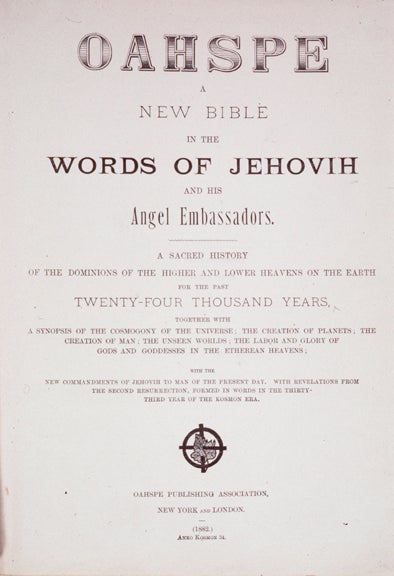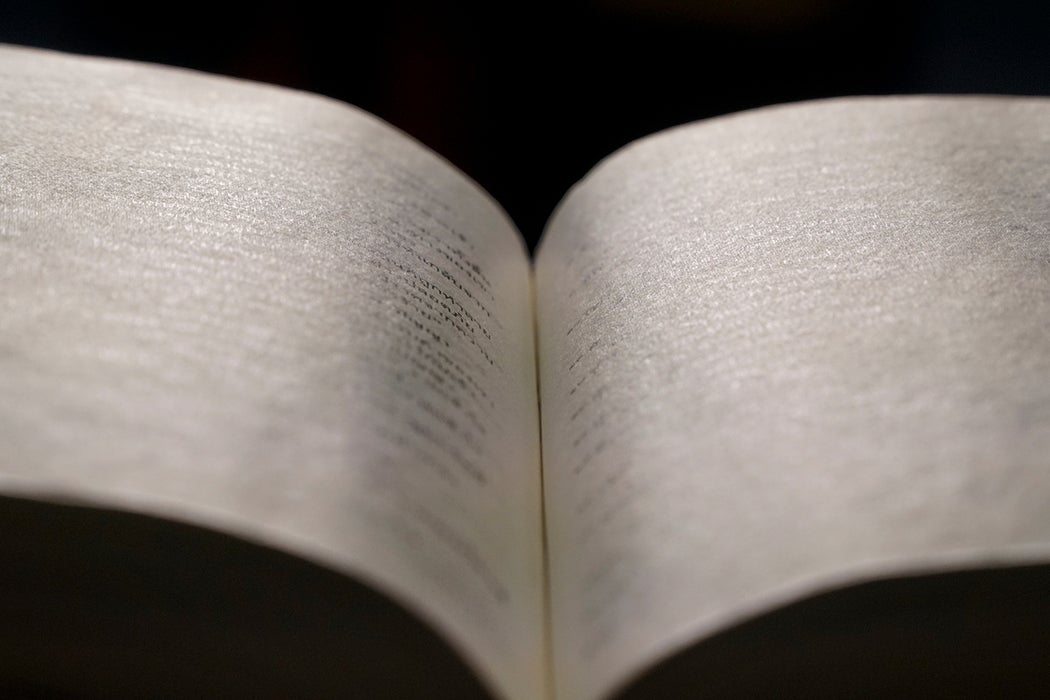In 1880, New York dentist John Ballou Newbrough bought his first typewriter. A year later, with the aid of an otherworldly entity, he had composed a nearly 1,000 page tome entitled OAHSPE: A New Bible. Purporting to chronicle 24,000 years of cosmological history, OAHSPE is a sprawling, idiosyncratic text. Its title is a neologism which, according to the book’s extensive glossary, means “the all,” and is “not a revelation intended to establish a new religion . . . but a reaffirmation of fundamental Truths.”
Beginning in the aftermath of the creation of humanity and concluding shortly after the abolition of slavery in the United States (Guatama in OAHSPE parlance), the book strives to draw together the spiritual and corporeal history of the cosmos. Although divided like the Bible into chapters and verses, its resemblance to Christian scripture is tenuous at best. But, as with many other alternative American scriptures of the nineteenth century, OAHSPE would likely not have existed had it not been for the profoundly influential tradition of the “plain Bible” that thrived in the eighteenth- and nineteenth-century United States.
In the decades following the social and political upheavals of the American Revolution, many Americans experienced a crisis of authority. During this time, the idea of an unambiguous “plain Bible” began to gain traction. According to religion scholar Lydia Willskey, the “plain Bible” was a Protestant theory of scripture, first articulated in the seventeenth century, which asserted that the Bible was not a mysterious text in need of elaborate interpretation but one whose “essential truths for salvation could be understood by even the uneducated and simple.” The thesis that the Bible was “clear in meaning, persuasive in message and authoritative in truth claims” was further nurtured in the eighteenth century by an Enlightenment faith in the senses and an “emphasis on the viability of reason.” In this iteration, all one needed to access the truths of scripture was a bit of common sense.

The problem with this characterization of the Bible was that it didn’t account for the wildly divergent experiences of readers. Were the Bible truly plain, observes Willskey, then “whatever reading appeared ‘plain’ to a given reader was the correct one.” One effect of this was to reinforce denominational divisions, which gave rise to even more confusion about the book’s real meaning. Rather than eliminating “the need for further inquiry” it actually “made further inquiry necessary.”
Thus, the dream of a “plain Bible,” rather than guaranteeing a universal form of encounter with sacred texts, only fractured it further. According to religion scholar Laurie Maffly-Kipp, many believers in the nineteenth century intuited what “the unleashed potential of a malleable scripture” might yield. The fruits of this intuition are evident in the glut of new scriptural texts published throughout the era, including The Book of Mormon (1830), the Shaker prophet Philemon Stewart’s A Holy, Sacred and Divine Roll and Book (1843), Mary Baker Eddy’s Science and Health (1875), and, of course, OAHSPE, to name only a few.
Weekly Digest
But this flood of alternative Bibles wasn’t simply a reaction to the ideology of a “plain Bible.” Each of these texts tried in their own way to fulfill the promise of a scripture that would unite theology, science, and cosmic history in such a manner that no reasoning person could dispute their claims. The Book of Mormon, for example, appeals to history, while Science and Health insists on the harmony of the gospels and science.
OAHSPE represents the most forthright instance of this gambit, beginning as it does with an admission that the divine imprimatur is not by itself sufficient to make a book meaningfully true. In his preface to the book, Newbrough reasons, “When a book gives us information of things we know not of, it should also give us a method of proving that information to be true.” A Bible, Newbrough believed—even a new one—ought to have “merits of its own” and to make its message plain.







